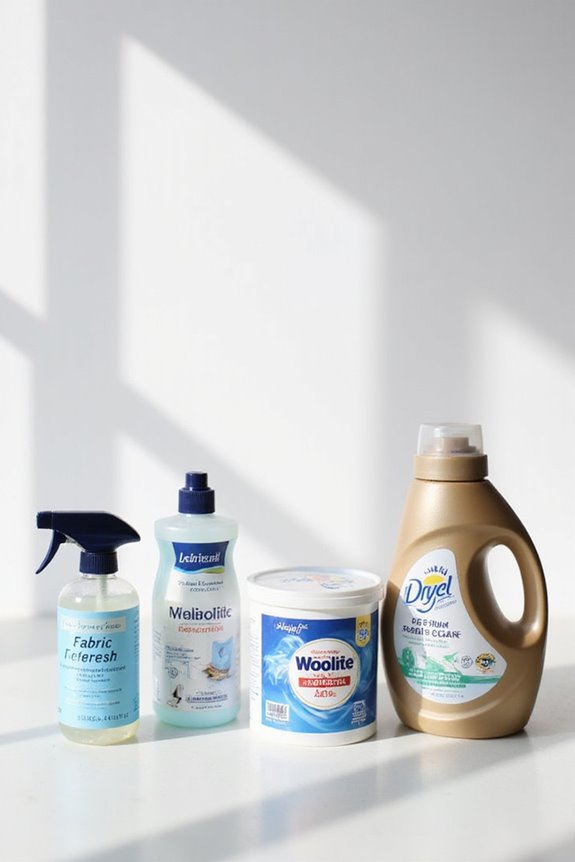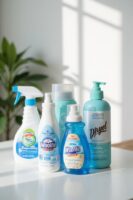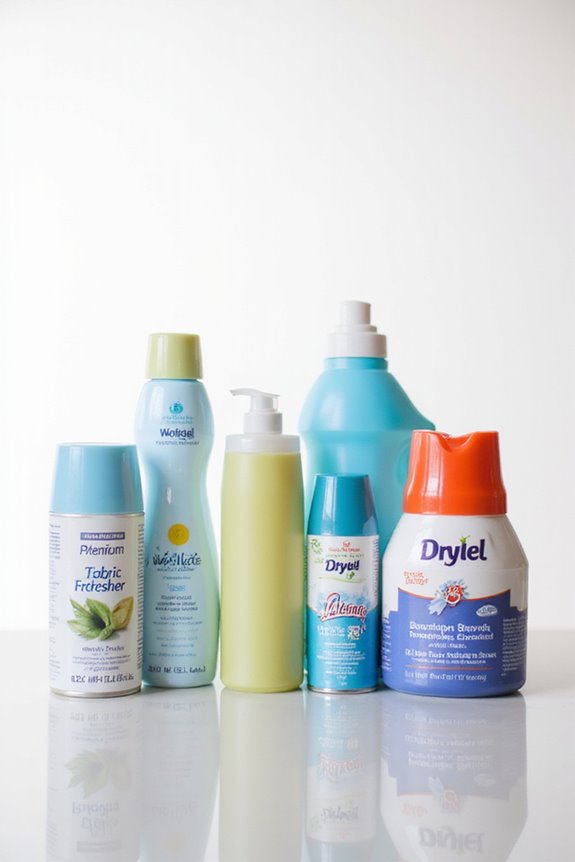Are fabric refresh sprays safe for all fabrics? Well, not quite. Most fabrics, like upholstery and rugs, are fine, but we should be cautious with delicate items, like silk or leather. Testing a hidden spot first is a smart move to avoid embarrassing surprises. We’ve found that gentle misting works best, so we don’t soak our clothes. Curious about the best practices to keep our fabrics fresh without harm? Stick with us to learn more!
Key Takeaways
- Fabric refresh sprays are generally safe for most fabrics, including upholstery and rugs.
- Caution is needed with delicate textiles such as silk or leather, which may be damaged.
- Testing a hidden area before full application is recommended to avoid discoloration.
- Non-toxic labels are important for safety around children and pets.
- Overuse can lead to chemical residues affecting both fabric texture and skin.
Overview of Fabric Refresh Sprays
When it comes to keeping our fabrics smelling fresh, fabric refresh sprays are pretty handy tools in our cleaning arsenal. These sprays usually include common ingredients like water, alcohol, and essential oils to tackle odors effectively. We can customize them to match our scent preferences, whether we enjoy lavender’s calming vibe or a zesty lemon burst.
For best results, we should consider usage frequency—using them too often might not be ideal for all fabrics. Remember to test a small area first, just in case! Plus, shaking the bottle well guarantees that all those wonderful ingredients mix properly. Additionally, it’s important to note that quick-drying formulas can help prevent sticky residues that might damage delicate fabrics. So, let’s keep our favorite fabrics smelling delightful and fresh, making our space feel just that much more inviting.
Compatible Fabrics for Use

After we’ve explored how fabric refresh sprays work their magic, it’s time to talk about which fabrics they actually get along with. Most fabric types, including upholstery, rugs, and car seats, are compatible. We’ve found that sprays like Downy Rinse and Refresh are safe for everything from our favorite athletic wear to baby clothes. They won’t leave heavy perfumes or dyes, making them gentle on skin-contact fabrics. Plus, synthetic fibers like polyester and nylon love these sprays too, helping to eliminate stubborn odors without damaging their elasticity. Natural fibers, like cotton and linen, can also benefit, but let’s not go overboard. Remember, a quick patch test is always a good idea to avoid any surprises! Additionally, be cautious with non-toxic labels, especially when using sprays around children or pets to ensure safety.
Cautions for Delicate Textiles
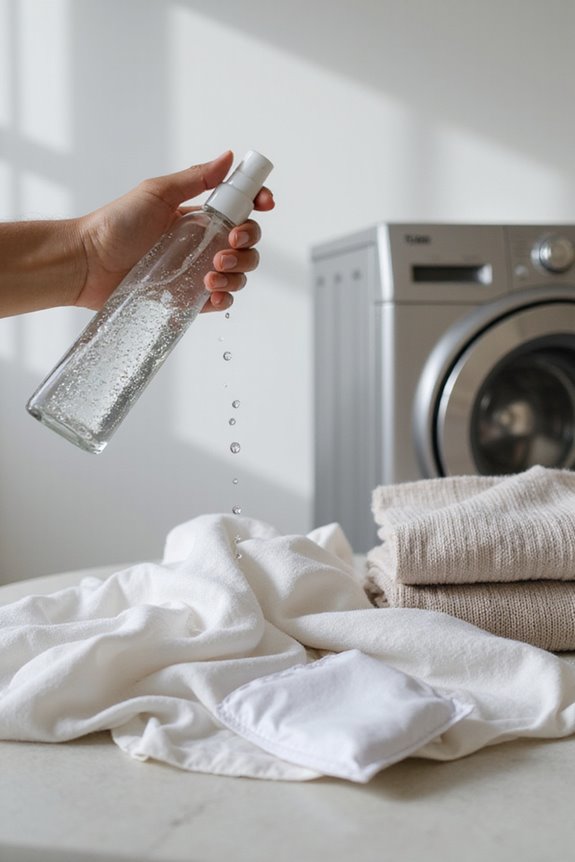
Caring for delicate textiles can feel a bit like walking a tightrope; one misstep, and you could damage your favorite silk blouse or lace curtains. That’s why we need to stick to some testing protocols before going full steam ahead. Always test fabric refresher sprays on a hidden spot first. It’s essential because colorfastness can be unpredictable, especially with silk or lace.
When applying, let’s remember to spray from a distance—about 5-6 inches. We should avoid soaking the fibers. A light mist is best, followed by gentle smoothing. And hey, let’s not spray while wearing the garment to dodge skin irritation. If we follow these application techniques, we can keep our delicate textiles looking fresh without a hitch! Additionally, using fragrance-free options is crucial for avoiding allergic reactions or skin irritations.
Chemical Composition and Effects
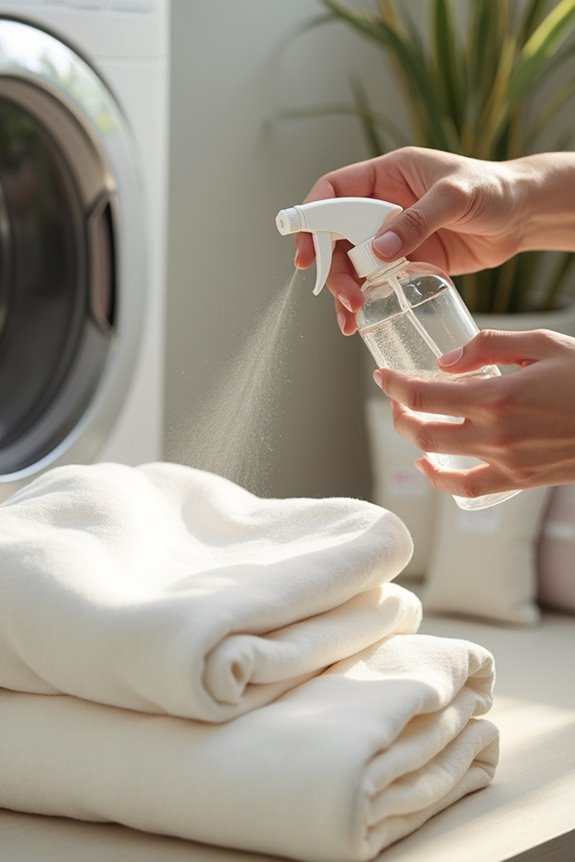
Understanding the chemical composition of fabric refresh sprays can really help us make informed choices. These sprays contain key ingredients like cyclodextrins, which trap odor molecules instead of just masking them. Diethylene glycol works alongside them, capturing a broader range of odors. We also see pH balancers like sodium citrate and sodium maleate, which neutralize odors effectively.
It’s interesting to note the ingredient interactions; for example, water serves as a solvent, ensuring even application. The combination of all these elements can lead to various chemical reactions, enhancing the product’s effectiveness. While we’ve tested different scents, it’s essential to read labels and be aware of what we’re spraying on our fabrics, ensuring safety and performance. Additionally, choosing sprays with eco-friendly ingredients can contribute to a safer environment while maintaining freshness.
Functional Benefits of Fabric Refreshers
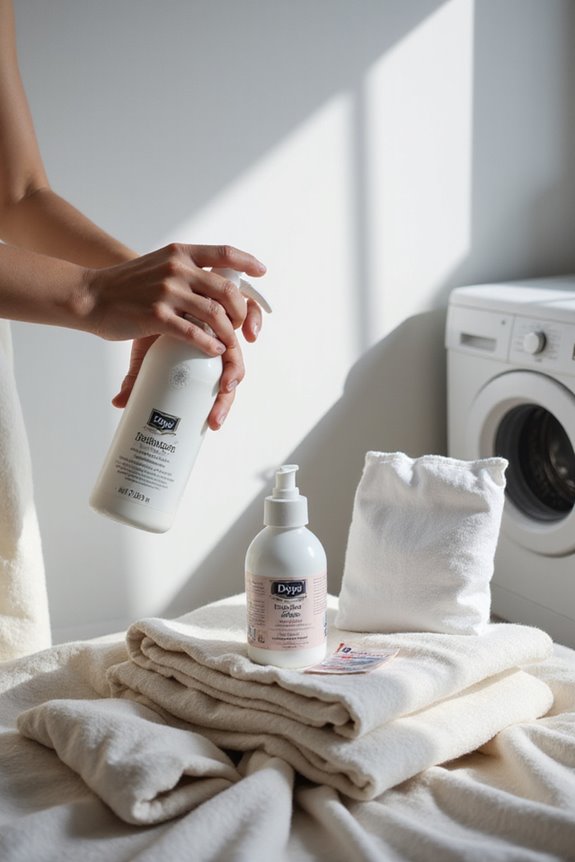
When it comes to keeping our fabrics fresh, fabric refreshers offer a world of benefits that go beyond just masking odors. They use effective odor neutralization techniques to eliminate smells from smoke, pets, and sweat. Plus, they extend the freshness of our clothes and upholstery between washes, saving us laundry time.
These sprays also provide handy wrinkle release methods, letting us touch up our garments without an iron. We can use them on delicate items, which is a lifesaver before a big event. They’re not just for clothes, either; they work wonders on shoes and even pet beds! Additionally, many fabric refreshers feature eco-friendly formulas that are safe for various materials, making them a great choice for conscious consumers. So, if we want to keep things fresh and save time, fabric refreshers are definitely worth considering.
Limitations and Precautions
While fabric refreshers can keep our clothes and upholstery smelling nice, it’s important to know their limitations and precautions. First off, we should be careful—these sprays can contain chemicals that might cause allergic reactions or respiratory irritation, especially for sensitive individuals. We’ve got to remember that some fabrics, like silk or leather, may get damaged or discolored.
Before we go all in, let’s test a small area first to avoid surprises. Also, overusing these sprays can lead to chemical residues that might irritate skin or affect fabric texture. And please, let’s avoid using them around open flames or mixing them with other products—they can be unpredictable! So, let’s use them wisely and keep our spaces fresh! Additionally, it’s crucial to choose hypoallergenic fabric sprays that are free from irritants to ensure safety.
Environmental Impact and Safety
As we explore the environmental impact and safety of fabric refresh sprays, it’s clear that not all options are created equal. Many sprays contain volatile organic compounds, or VOCs, which can pollute our air and even cause health issues. So, it’s wise to check the labels! We should also consider the propellants used. Inert gases like nitrogen are non-toxic and environmentally friendly, while hydrocarbons can harm the ozone layer. Sustainable sourcing is key here—choosing products with biodegradable ingredients helps reduce long-term environmental impact. Personally, I’ve noticed that some greener options might cost a bit more or spray differently, but balancing environmental safety with performance is definitely worth it. After all, who wants to harm the planet while freshening up their couch?
Best Practices for Safe Application
To guarantee we’re using fabric refresh sprays safely and effectively, it’s important to follow a few best practices. First, let’s keep our application distance around 6-8 inches. This guarantees even dampening without soaking the fabric. We should target small areas initially for fabric testing, so we can check for any discoloration. Using sweeping motions helps us avoid wet spots, which is key for a neat finish.
Let’s also remember to test on sensitive fabrics like leather or silk, as they can be tricky. After applying, air-dry the fabric completely to avoid mildew. Finally, we should store our sprays properly to keep them fresh. With these application techniques, we can enjoy our refreshed fabrics worry-free!
Frequently Asked Questions
Can Fabric Refreshers Be Used on Outdoor Cushions?
Yes, we can use fabric refreshers on outdoor cushions made from various outdoor fabrics. Just remember to spot test first, especially on different cushion materials, to guarantee there’s no adverse effect on color or texture.
How Often Can I Safely Use Fabric Refresher Sprays?
When considering fabric refresher frequency, we should apply sprays as needed, following safe application tips. Testing on a small area first helps guarantee we avoid damage, especially on delicate fabrics that require less frequent use.
Do Fabric Refreshers Leave a Residue on Fabrics?
When we consider residue effects, it’s essential to assess fabric compatibility. Some sprays do leave a residue that can affect texture and breathability, so we should choose carefully and test on small areas first.
Are There Any Homemade Alternatives to Commercial Fabric Refreshers?
We’ve discovered delightful homemade recipes using natural ingredients like water, alcohol, and essential oils. These simple solutions can freshen fabrics beautifully while avoiding synthetic substances, offering a budget-friendly and customizable alternative to commercial sprays.
Can I Use Fabric Refreshers on Pet Bedding?
Absolutely, we can use fabric refreshers on pet bedding! Just make sure they’re pet-safe and compatible with the bedding materials. It’s crucial to check labels for pet safety and ingredient transparency before applying.

